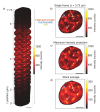Combined optical fluorescence microscopy and X-ray tomography reveals substructures in cell nuclei in 3D
- PMID: 36187264
- PMCID: PMC9484410
- DOI: 10.1364/BOE.462493
Combined optical fluorescence microscopy and X-ray tomography reveals substructures in cell nuclei in 3D
Abstract
The function of a biological cell is fundamentally defined by the structural architecture of packaged DNA in the nucleus. Elucidating information about the packaged DNA is facilitated by high-resolution imaging. Here, we combine and correlate hard X-ray propagation-based phase contrast tomography and visible light confocal microscopy in three dimensions to probe DNA in whole cell nuclei of NIH-3T3 fibroblasts. In this way, unlabeled and fluorescently labeled substructures within the cell are visualized in a complementary manner. Our approach enables the quantification of the electron density, volume and optical fluorescence intensity of nuclear material. By joining all of this information, we are able to spatially localize and physically characterize both active and inactive heterochromatin, euchromatin, pericentric heterochromatin foci and nucleoli.
© 2022 Optica Publishing Group under the terms of the Optica Open Access Publishing Agreement.
Conflict of interest statement
The authors declare no conflicts of interest.
Figures






References
LinkOut - more resources
Full Text Sources
